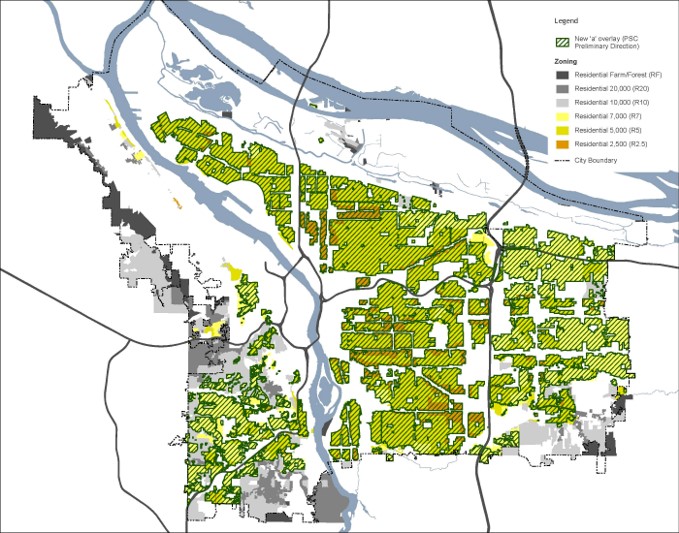As people flock to Portland, a crucial question arises: Where are all these people going to live?
High-rise construction, despite its prevalence in the city, isn’t meeting the demand for housing, and rents continue to rise above national averages. City planners estimate that Portland will grow by more than 100,000 households by 2035. As a result, both city and state officials have looked to zoning codes to accommodate—and anticipate—need.
Zoning 101
Zoning is the act of dividing parts of town into categories intended for different purposes. For example, Portland has zones that are purely commercial, and others intended for both residents and businesses. Zones have height limits and other restrictions.
But say you aren’t a city planner or an architect. What does zoning have to do with you?
It turns out, a lot.
Zoning shapes the way you walk through your neighborhood. It explains why you can never seem to find parking in a certain part of town. It sets aside open spaces for parks and recreational areas.
Whether you rent a one-bedroom apartment or own a house in the hills, the following zoning proposals could affect you.
For Urban Dwellers
City planners are working on a holistic approach to meet housing demand in increasingly urban neighborhoods. The Better Housing by Design project is intended to improve quality of life while increasing density.
The Northwest District will be one of the most affected areas of the city.
Because of Portland’s urban growth boundary, the city must grow up, rather than out. This project does that by increasing height maximums and allowing some mid-rises to become high-rises near the Central City.
But as apartments gain square footage, they must also provide common green spaces for residents. For example, large sites with more than 20,000 square feet must also have a courtyard, eco roof or other outdoor space available.
One of the city’s greatest concerns continues to be affordable housing, so the project offers incentives to developers who sell units at affordable rates.
Better Housing by Design will continue to be workshopped in 2019 before it reaches City Council. You can read the proposed draft summary here.
The “Missing Middle”
Across the United States, it can be difficult for renters to find options between single-family homes and high-rise apartments. This gap is often referred to as the “Missing Middle,” and it’s an issue growing in urgency as Portland and other cities see influx.
Willamette Week reports that more than 70 percent of Portland’s residential land is zoned for single-family housing. Two proposals, one city and one state, seek to curb single-family zoning to allow for duplexes, triplexes and other multiplex options.
“Smaller households tend to eat out more, helping our neighborhood attract wonderful restaurants,” said Ellen Dunham-Jones, professor and co-author of Retrofitting Suburbia. “Diverse households keep diverse hours meaning we have more people out walking our streets at more varied hours—keeping them safer.

For Suburbanites
For years, the city has struggled to coordinate legislation addressing “Missing Middle” housing options, though it supports the concept. The government’s latest effort, called the Residential Infill Project (RIP), would allow, but not require, multiplex options in 96 percent of current single-family zones.
That zoning change could add more than 24,000 units in the next 20 years, according to a recent Johnson Economics report the city commissioned. This estimate includes predicted demolitions, a point of contention for RIP critics who worry about the potential homes lost to re-zoning.
The report expects average rents to drop by 56 percent because of smaller unit sizes and increased availability.
Of NWNW’s neighborhoods, Sylvan-Highlands, Arlington Heights and Hillside will see the greatest impact. Some parts of Linnton have been excluded from the plan because of landslides and other environmental risks, Project Manager Morgan Tracy said.
The project is currently under review by the Planning and Sustainability Commission and will make its way to City Council in summer 2019. You can read the proposed draft summary here.

Image courtesy of the Bureau of Planning and Sustainability.
State of Oregon Proposal
Oregon House Speaker Tina Kotek is reportedly drafting legislation to abolish single-family zoning in cities with more than 10,000 residents. The Oregonian reports that more than half of the state’s population lives in cities the plan would affect.
The proposal would require these cities to both devise and implement the required zoning change within 16 months. The state would provide funding for the updates and incentivize construction of the new homes by deferring certain charges before completion.
Kotek’s announcement came one week after Minneapolis announced its own ban on single-family zoning, becoming the first major city in the U.S. to do so.
“The state’s housing crisis requires a combination of bolder strategies,” Kotek said in a statement. “That’s a fight that I’m willing to take on.”
Note: This article is for informational purposes. Neighbors West-Northwest does not endorse city projects. To learn more about how your neighborhood may be affected, contact your neighborhood association or the Bureau of Planning and Sustainability.
Better Housing by Design: betterhousing@portlandoregon.gov
Residential Infill Project: residential.infill@portlandoregon.gov

